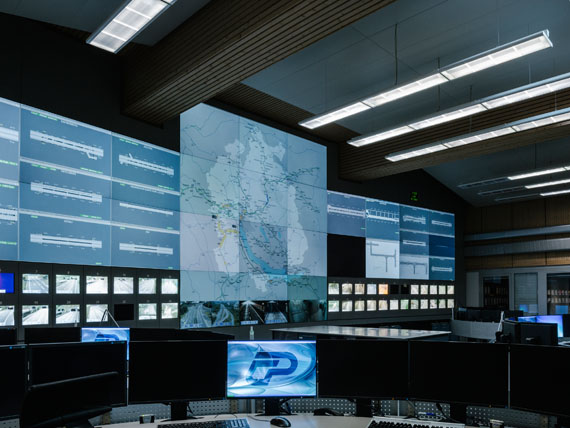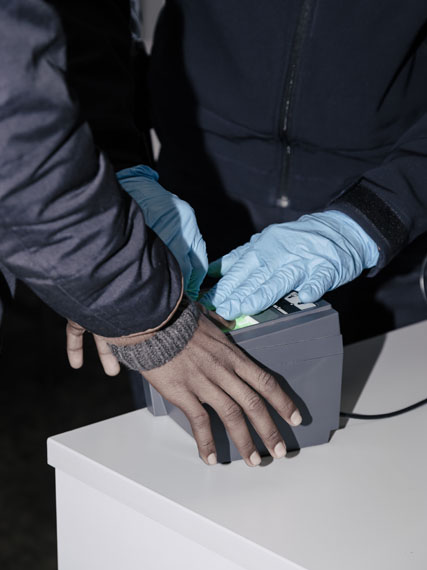
from the series "How to Secure a Country"
© Salvatore Vitale
Salvatore Vitale »
How to Secure a Country
Exhibition: 23 Feb – 26 May 2019
Fri 22 Feb 18:00
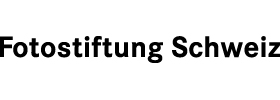
Fotostiftung Schweiz
Grüzenstr. 45
8400 Winterthur
+41 52 -234 10 30
info@fotostiftung.ch
www.fotostiftung.ch
Tue-Sun 11-18, Wed 11-20
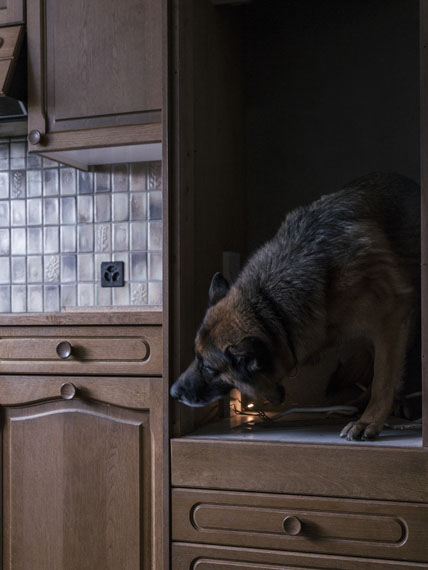
from the series "How to Secure a Country"
© Salvatore Vitale
Salvatore Vitale
"How to Secure a Country"
Exhibition: 23 February – 26 May, 2019
Opening: Friday, 22 February, 6pm
Switzerland is well-known as one of the safest countries on earth and as a prime example
of efficiency and efficacy. But how do state and private actors ensure this valuable commodity,
which is as much a basic need as it is a billion-dollar business? And how much
freedom are we as citizens willing to give up for our security? Between 2014 and 2018,
Salvatore Vitale (born 1986 in Palermo, lives in Lugano and Zurich) set out on a visual
research project, to discover the central underlying tenets for such a country to evolve,
exist and endure. One of the central conditions he made out is the development of a
culture based on securing, protecting, insuring and preventing, which is supported by the
presence and production of national security.
In order to do this, Vitale investigated the social and technological mechanisms underlying this
preventive and defensive shield and takes a close look at the various institutional protagonists
involved — police, military, customs and migration authorities, weather services, IT companies,
and research institutions for robotics and artificial intelligence.
It positions itself as a contemporaneous artistic contribution to debates in a society that is
confronted with growing threats — real or perceived — from terrorism and cybercrime, surveillance
and data misuse. It also inscribes itself into current Swiss political debates on Swiss
arms exports and citizen privacy.
The project explores visually the ways in which social, political and psychological phenomena,
which are most of the time invisible and somewhat elusive, become stabilized and therefore
also visible through standard operating procedures and protocols. By tracing networks connecting
the activities of data storage and insurance companies, weather forecasting services
as well as the police, the military, or state-run organizations related to customs and migration,
it traces and visually maps what could be referred to as a Swiss public-private security complex.
Vitale’s goal was to capitalize on the actual fluidity and abstractness of the country’s security
measures and to photographically re-appropriate and re-code the "matter-of-factness" of the
instruction manuals and protocols found in bureaucratic procedures. In this way, its paradoxical
nature becomes apparent by looking at how "clear-cut" solutions are applied to what are, in
fact, often highly fleeting phenomena. It means to trace and render visible the complexities
that lie behind the Swiss security industries by providing a view from the inside thanks to an
active collaboration with its actors and institutions.
In "How to Secure a Country" Vitale and his collaborators reflect and visualize the production of
security (and therefore also insecurity) in photographs, texts, and data visualizations. The result
aims at grasping the wider contexts and the functioning of an exemplary contemporary society
that is in many ways emblematic of social, political and economic vectors and trends globally.
Seen in this perspective Switzerland is part of globalization processes — as a localized node
and point of culmination of many globalized flows and movements, but not based on a theory of
historical exceptionalism.
The installation of the exhibition goes far beyond "just" presenting photographic works on walls.
Instead, it uses the open-plan space of the Fotostiftung Schweiz in order to generate a complex
informational environment to be experienced with multiple senses by the visitors, as they
manoeuvre a flexible itinerary activating the above components in different configurations and
media. As alluded to above, multiple registers and layers of other visual material will make up
important parts of the exhibition’s display strategy. The exhibition, then, is organized to be experienced as a forest of signs, an urban landscape of photographic images, a selective "grand tour" of the Swiss security system, which as we will argue in this book could be seen as the epitome of national and transnational securitization strategies globally.
The work focuses on some of the pressing and relevant socio-political, aesthetic and technological
issues of our time. It was conceived as a think-tank or aggregator for the structuring of
the complex field of the Swiss security complex, addressing various levels of popular culture,
politics of representation and current societal discussions of security, privacy and risk management,
and technology.
Fotostiftung Schweiz presents the first comprehensive exhibition of this body of work.
Salvatore Vitale (b. 1986, Palermo, Italy) is a Swiss-based visual artist and editor. Master of Fine Arts at the Zurich University of Arts (ZHdK). He was a recipient of the Swiss Arts Council grant in 2015-2016, the PHmuseum Award Grant in 2017, the Swiss Design Awards, FOAM
Talent and Punctum Award in 2018. His work has been shown in museums and at photo festivals
including the Photoforum Pasquart Biel/Bienne, OCAT Shanghai and Shenzhen, MOCAK –
Museum of Contemporary Art Krakow, Hamburg Triennale of Photography, T3 Photo Festival
Tokyo, and Jaipur International Photography Festival. He teaches at the Lucerne University of
Applied Sciences and Arts (HSLU) and he has led workshops worldwide. Vitale is also the cofounder
and editor-in-chief of YET magazine, a Swiss-based international photo-graphy magazine
that focuses on the evolution of photography practice within the contemporary art field.
Lars Müller Publishers is publishing the book: "How to Secure a Country. From Border Policing via Weather Forecast to Social Engineering — a Visual Study of 21st Century Statehood". Edited by Salvatore Vitale and Lars Willumeit. Incollaboration with Fotostiftung Schweiz, Winterthur. With essays by Roland Bleiker, Jonas Hagmann, Philip Di Salvo, and Lars Willumeit. English language. Design: Offshore Studio. 296 pages, 192 illustrations, hardcover.
Guest curator: Lars Willumeit
�
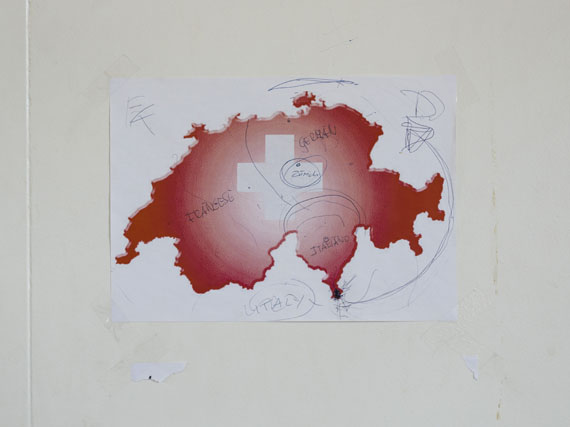
from the series "How to Secure a Country"
© Salvatore Vitale
Salvatore Vitale
"How to Secure a Country"
Ausstellung: 23. Februar bis 26. Mai 2019
Eröffnung: Freitag, 22. Februar, 18 Uhr
Die Schweiz gilt als eines der sichersten Länder der Welt und als ein Musterbeispiel für Effizienz. Die Frage, wie sie sich gegen alle Arten von Risiken, Gefahren und Bedrohungen abzusichern versucht, hat Salvatore Vitale (geb. 1986 in Palermo, in Lugano und Zürich lebend) zu einem visuellen Forschungsprojekt bewogen. Zwischen 2014 und 2018 hat er untersucht, wie Schutz- und Präventionssysteme unseren Alltag, unsere Verhaltensweisen und unser Denken durchdringen. Das Projekt reflektiert und verbildlicht die Herstellung von Sicherheit (und damit auch von Unsicherheit) durch Fotos, Texte und Datenvisualisierungen.
Das daraus erwachsene Langzeitprojekt "How to Secure a Country" versucht die scheinbar obsessive Beschäftigung mit Sicherheit sichtbar zu machen: die Vorkehrungen, Einstellungen, Infrastrukturen, Codes und Protokolle, die sowohl im individuellen Verhalten als auch in der politischen Diskussion zum Beispiel zu Themen wie Migration zu beobachten sind.
Salvatore Vitales Untersuchung geht dabei vom institutionellen Netzwerk aus – Polizei, Militär,
Zoll- und Migrationsbehörden, Wetterdienste, IT-Unternehmen sowie Forschungsstellen für
Robotik und Künstliche Intelligenz. Das Ziel, die teilhabenden Akteure zu identifizieren, den
Zugang zu ihnen zu erlangen und sie fotografisch zu dokumentieren, offenbarte sich jedoch
rasch als Herausforderung. Denn nicht nur sind die Bedrohungen – reale oder wahrgenommene
– oft unsichtbar und schwer fassbar. Auch die dagegen entwickelten Präventions- und Schutzschilde sind es. Oft handelt es sich dabei um standardisierte Handlungsabläufe und Wegleitungen, Organisationsmodelle und Netzwerke, die abstrakt, nüchtern und gesichtslos sind.
Dennoch – so legt die fotografische Arbeit nahe – manfestiert sich die Essenz dieses Sicherheitsapparats als ästhetisch wahrnehmbare Disposition, die mit den Mitteln der Fotografie
erforscht und vermittelt werden kann. Das Projekt interessiert sich so zum Beispiel für die
Untersuchung von Fragen wie: Warum machen sich die Schweizer Streitkräfte Gedanken über
das jährliche Sorgenbarometer? Wie funktioniert die integrierte Grenzverwaltung? Was hat das
Réduit mit Bitcoin und Cyber-Sicherheit zu tun? Und was bedeutet Predictive Policing in der
Polizeiarbeit?
Dank einer aktiven Zusammenarbeit mit verschiedenen Spezialisten und Forschern gelingt es
Salvatore Vitale, die Komplexität der Schweizer Sicherheitsindustrie offenzulegen. Durch sie
erhielt er Zugang zu Orten, die ansonsten abgeschottet sind. So vermag er die oftmals abstrakte
Erzeugung von Sicherheit auf eine konkrete Weise erlebbar zu machen – seine Arbeit
leistet eine Art Kartographierung dessen, was man als öffentlich-privaten Sicherheitskomplex
der Schweiz bezeichnen könnte. Salvatore Vitales Vorhaben positioniert sich somit als zeitgemässer künstlerischer Beitrag zu einer Debatte in einer Gesellschaft, die sich mit einer wachsenden Bedrohung konfrontiert sieht. Mit seinem Werk schaltet er sich ebenso in eine
gegenwärtige politische Debatte in der Schweiz ein, bei der es etwa um Schweizer Waffenexporte
und die Privatsphäre der Bürger geht.
Das Forschungsprojekt wird von einem Buch begleitet, das die Fotografie mit verschiedenen Textformen und Datenvisualisierung kombiniert. Und auch die Ausstellung geht weit über die "reine" Präsentation von Fotoarbeiten hinaus. So entsteht in der Fotostiftung Schweiz eine komplexe Informationsumgebung, die von den Besuchern mit unterschiedlichen Sinnen erfahrbar ist, bestehend aus Karten, Statistiken und Grafiken, einer interaktiven, Sensor-modulierten Audio-Installation sowie einer Video-Installation mit zwei Projektionen an Decke und Boden. Ferner wird präsentiert, wie sich ein Cyberangriff auf einen infizierten Rechner auswirkt. Durch die Einbindung mehrerer "Forschungstische" in den Ausstellungsparcours werden Onlinequellen wie Filmmaterial sowie Druckerzeugnisse zugänglich gemacht, die einen tiefer gehenden Einblick in das Thema gewähren.
Ungewöhnlich für eine Fotoausstellung ist auch, dass keine der Fotografien an einer Wand
präsentiert wird, sondern auf eigens dafür hergestellten, im Raum verteilten Metallkonstruktionen. So entsteht ein narrativer Parcours, auf dem man die thematischen Kapitel als Cluster physisch erkunden und sinnlich erfahren kann. Sowohl die Gestaltung der Ständer, auf denen die Fotografien gezeigt werden, als auch das allgemeine Informationsdesign sind unter anderem
inspiriert von der Ästhetik kommerzieller Sicherheitsmessen und wissenschaftlicher
Bedienungsanleitungen im Bestreben, sich deren visuelle Register anzueignen und sie ins
Bewusstsein zu heben. Das Projekt versucht somit Sprach- und Bildpolitiken aufzudecken, wie
sie im Kraftfeld des transnationalen Sicherheitssystems verwendet werden. Dieser Ansatz
steht im Einklang mit Salvatore Vitales beklemmender Bildsprache: Vorrangig ist nicht ein
investigativer Ansatz mit dem Ziel der Entlarvung, sondern das Bemühen, schwer fassbare
gesellschaftliche Befindlichkeiten sowie die strukturelle Gewalt des Systems spürbar zu
machen.
Die Ausstellung ist als multiperspektivischer Denkraum und Aggregator konzipiert und erscheint als ein Wald aus Zeichen, eine urbane Landschaft aus fotografischen Bildern, eine selektive "Grand Tour" des Schweizer Sicherheitssystems, das man in globaler Hinsicht als Inbegriff nationaler und transnationaler Sicherheitssysteme betrachten kann. Sie fokussiert auf einige der relevantesten gesellschaftspolitischen und technologischen Themen unserer Zeit.
Die Fotostiftung Schweiz präsentiert die erste umfassende Ausstellung dieses Werkkomplexes.
Salvatore Vitale (geb. 1986 in Palermo, Italien) ist ein in der Schweiz lebender Künstler und Publizist. Masterstudium der Bildenden Kunst an der Zürcher Hochschule der Künste (ZHdK). 2015–2016 erhielt er ein Pro Helvetia Nachwuchsförderungs-Stipendium und 2017 das PHmuseum-Award-Stipendium. 2018 wurden ihm ein Swiss Design Award, der FOAM Talent
Award und der Punctum Award verliehen. Seine Werke sind in Museen und bei Foto-Festivals
ausgestellt worden: u.a. im Photoforum Pasquart Biel, OCAT Shanghai und Shenzhen, MOCAK –
Museum für Gegenwartskunst Krakau, Triennale der Photographie Hamburg, T3 Photo Festival
Tokio und Jaipur International Photography Festival. Er lehrt an der Hochschule Luzern (HSLU)
und hat weltweit Workshops geleitet. Salvatore Vitale ist darüber hinaus Mitbegründer und
Chefredakteur von "YET", einer in der Schweiz erscheinenden internationalen, der zeitgenössischen Fotografie gewidmeten Zeitschrift.
Bei Lars Müller Publishers erscheint die Publikation "How to Secure a Country. From Border Policing via Weather Forecast to Social Engineering — a Visual Study of 21st Century Statehood". Herausgegeben von Salvatore Vitale und Lars Willumeit. Mit Essays von Roland Bleiker, Jonas Hagmann, Philip Di Salvo und Lars Willumeit. In englischer Sprache. Design: Offshore Studio. 296 Seiten, 192 Illustrationen, Hardcover.
Gastkurator: Lars Willumeit�
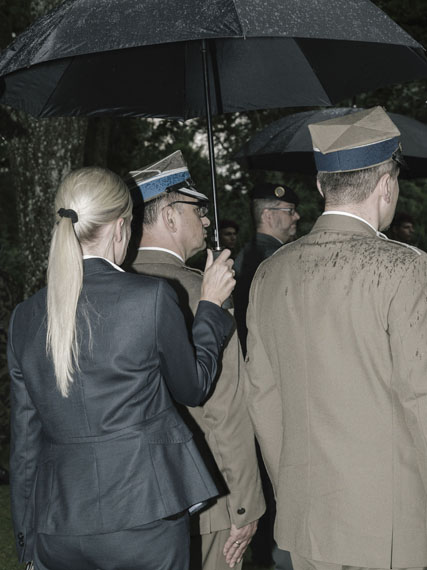
from the series "How to Secure a Country"
© Salvatore Vitale
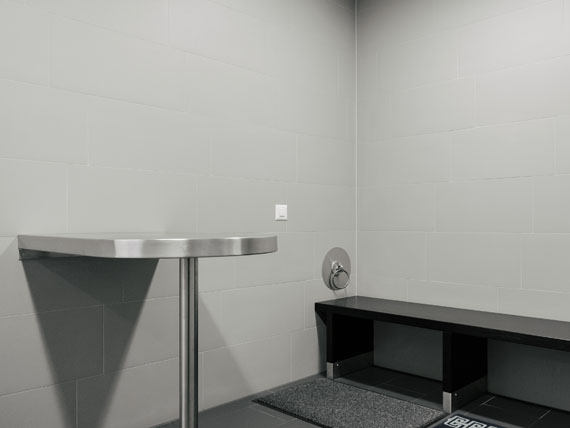
from the series "How to Secure a Country"
© Salvatore Vitale
